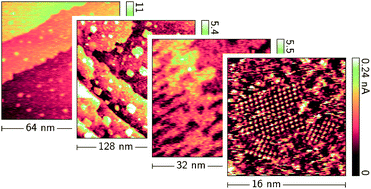We have explored the adsorption of zinc-free human insulin on the three low-index single-crystalline Au(111)-, Au(100)- and Au(110)-surfaces in aqueous buffer (KH2PO4, pH 5) by a combination of electrochemical scanning tunnelling microscopy (in situ STM) at single-molecule resolution and linear sweep, LSV, cyclic, CV, and square wave (SQWV) voltammetry.
Multifarious electrochemical patterns were observed. Most attention was given to reductive desorption caused by insulin binding to the Au-surfaces via up to three disulfide groups per insulin monomer, presumably converted to single Au–S links. SQWV suggested the Au–S bond strength order Au(111) > Au(110) > Au(100) based on the reductive desorption potentials. The voltammetric diversity was paralleled by different in situ STM insulin adsorption modes on the three surfaces. Single-molecule resolution was achieved in all cases. The coverage followed the order Au(110) > Au(100) > Au(111) and differs from the reductive desorption order that records the Au–S bonding element. Evenly distributed single molecules were scattered over large Au(111)-terraces, with intriguing molecular arrays disclosed near the terrace edges. In comparison, high-density molecular scale structures were observed both over the terraces and across terrace edges on Au(100). Larger rectangular structures also appeared (8–12% coverage). These are Au-islands from the lift of the reconstruction. Notably, 10 × 10 nm2 patches of highly ordered much smaller structures, possibly from insulin decomposition emerged sporadically within the dense insulin adlayer. Insulin adsorbed in highest coverage on the Au(110) and followed the directional surface topology with insulin molecules aligned in the Au(110)-surface grooves, occasionally “spilling over” and merging into larger structures.
Adsorption, Au–S binding, and insulin unfolding are all parts of insulin surface behaviour and reflected in both voltammetry and in situ STM. In spite of these complications, the data show that molecular scale resolution has been achieved and offer other perspectives of insulin surface science such as single-molecule mapping of the insulin monomer/dimer-hexamer interconversion.


 Please wait while we load your content...
Please wait while we load your content...